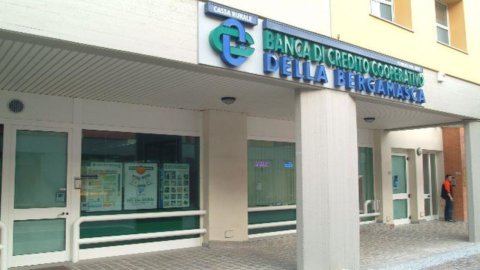In a previous article (Firstonline of 14 October) we decided to inaugurate, obviously not without a pinch of self-irony, a new literary genre, taking inspiration from the fragmentary Greek poets, those whose verses have been found on some piece of earthenware. This in the belief that to describe and comment on what is happening in our banking system at the time of the new European supervisory framework, individual flashes, fragments of discussion, rather than complicated summary representations, may be more effective. We would therefore intend to continue with this metaphor, presenting other fragments, numbered in close sequence with the previous ones, apologizing for what an inevitable repetition. For the moment, the most important issue at the moment continues to be the cooperative banking reform and its most recent evolutions. And we continue to talk about this.
Fragment 4 – Merge! But remember that there is consolidation and consolidation
For many years we have argued both with banks and with supervisors that bank consolidations were a way to strengthen the credit system as a whole and the cooperative system in particular. We weren't the only ones convinced of it, but given the results until recently, it was certainly not a shared thought. The world has changed! Today, we talk about nothing else. And, something is actually moving especially between the CCBs. In some territories, banks that previously looked at each other askance merge, mergers take place in threes, even fours, some slightly larger banks, inspired by sudden altruism, incorporate (or swallow?) one, two, three banks in a flurry with non-secondary criticalities, so much so as to seem like the fatebenefratelli. Social bases are born from 15/20.000 members, of which nothing is known of the actual degree of future cohesion.
They also become partners in discontinuous territories to their own to open secondary offices and expand the competence no longer like wildfire, but patchy. A ferment, a merger mania as a function of the cooperative banking group promoted by the reform to come or to distance itself from it, affirming unquestionable rights to autonomy (see also the following fragment)? It is not yet known, but one fact is certain. It does not seem that so far there has been much effort to explain to the shareholders (informed only by press revelations) what the industrial plan underlying these combinations is, such as the sustainability calculations of the projects and the expected medium/long-term benefits from a banking of larger dimensions, how post-merger redundancies will be reabsorbed, other structural costs reduced, starting with technology, the range of services expanded, the values of credit assets realigned.
Objective elements which, at the time of zeroing the spread between loans and deposits, become constituent elements of banking survival. Without these characteristics, the current trend is not easily explained when the cooperative banking movement itself, with a great effort that has not yet been completed, proposes the creation of a group, made up of new rules and more robust and competitive industrial prospects. It can be said that if the individual components are stronger, so will the peer group. But this must be demonstrated and not assumed on faith. In short, the flock that goes in no particular order is not really a flock and larger sheep are not said to be sheep capable of giving more milk and more wool to their territories.
In summary, we would not like to see in certain choices of "dimensionism", which have suddenly become fashionable, a kind of last resort defense of a concept of autonomy that is no longer sustainable. Referring to a well-known science fiction book, we should ask ourselves which sheep the cooperative member really dreams of. Is it the same as those who boldly put themselves at the head of these operations, which sometimes seem to be made out of personal ambition rather than a clear strategic plan? We'll see if stronger organisms or new weaknesses arise.
Fragment 5 – The Bank of Italy officially pronounces itself on the Reform of the mutual banks
The intervention of the Head of Supervision a few days ago in the Senate, prompted, as on many other occasions, by the unavoidable need to remedy the structural problems of the cooperative banking system, officially consecrated the position of the Bank of Italy, pronouncing of a reform centered on the so-called Joint Cooperative Group. This solution is based on the devolution to a holding company, the parent company, of prerogatives such as guidance, coordination and control of the adhering mutual banks and on the construction of a network of cross guarantees, to strengthen, thanks to the lower capital absorption, the degree of resistance to system risk. The picture is completed by the possibility of drawing additional resources from the market via the holding itself.
In short, it is an insurance-type model, where the number of members pays off and in which the strongest mutual banks undertake, in the name of cooperative solidarity sanctioned by a cohesion pact, to support the more fragile ones, which for their part are calls to give up greater levels of autonomy. So far, the model has its foundation. Some doubts arise when the Supervisory Authority itself claims that several competing groups can access this scheme. The complexity of balancing several forces in tension could give rise to virtuous groups on the one hand and groups of weak banks on the other and not that optimal mix, which is simply desired, where positive and negative differences are mediated.
In this phase, more than the competition, stability is needed to relaunch the system and therefore the greatest possible robustness on the part of the new configuration. Among other things, the resources are not unlimited and any dispersion could frustrate the basic objective. Should non-unitary solutions prevail, the minimum capital to set up a group should be identified by the supervisory authorities at a level of effective selectivity, to discourage too easy self-propositions. In practice, it should not be very different from that of the Iccrea banking group which is a bank at systemic risk at European level, to ensure that the playing field is leveled and to prevent the entire cooperative credit apparatus from being weakened by the effect of competition between components, also different in their subjection to regulation.
As regards the options for leaving the Joint Group, it then seems limiting to reconfirm only those currently envisaged pursuant to art. 36 of the TUB (assumption of popular status, transformation into joint stock company, and only for reasons of stability), when our civil law provides for the possibility of articulating cooperative activities also through the spin-off and the establishment of joint-stock companies, under the control of a cooperative society. And this, without prejudice to the founding elements of the prevailing mutuality and cooperative continuity, with the right to keep the indivisible reserves accumulated up to that moment. We are also of the opinion that hypotheses of taxation, aimed at their alleged liberation, as we hear from time to time, should be removed, given that this would represent, in our opinion, a threat to the cardinal principles of Italian cooperation. And we don't believe that anyone, starting with politics, wants to try this path.





